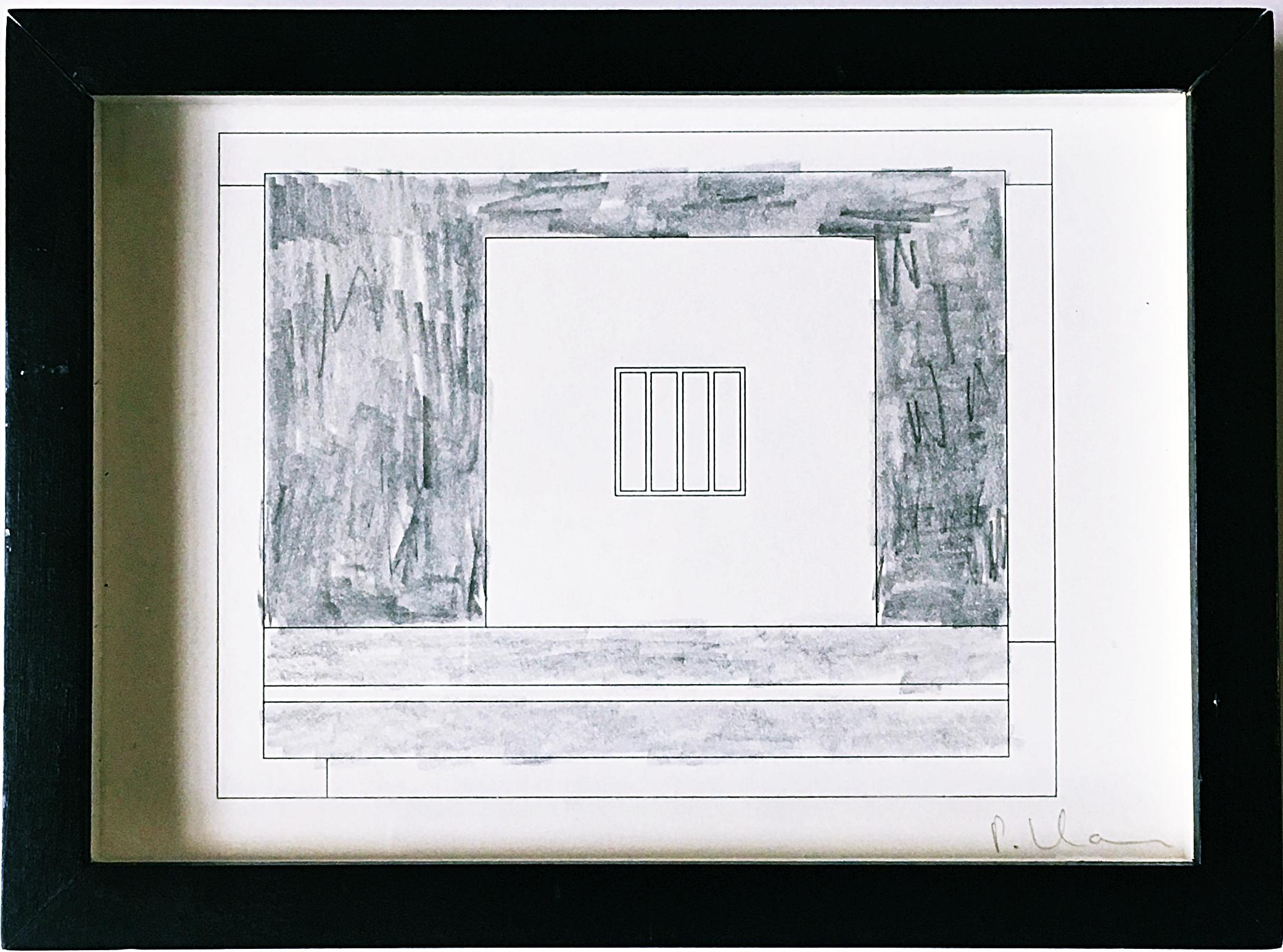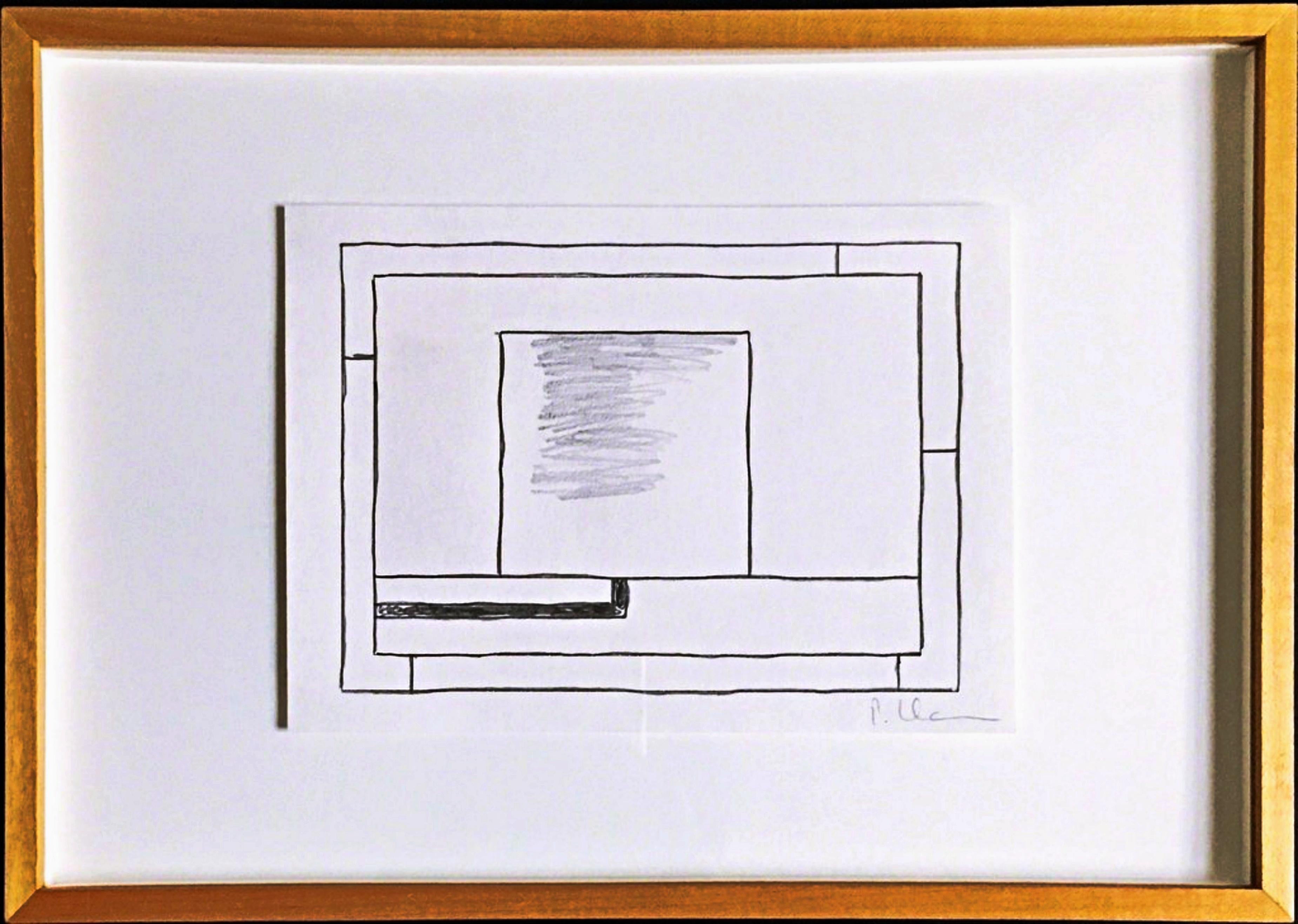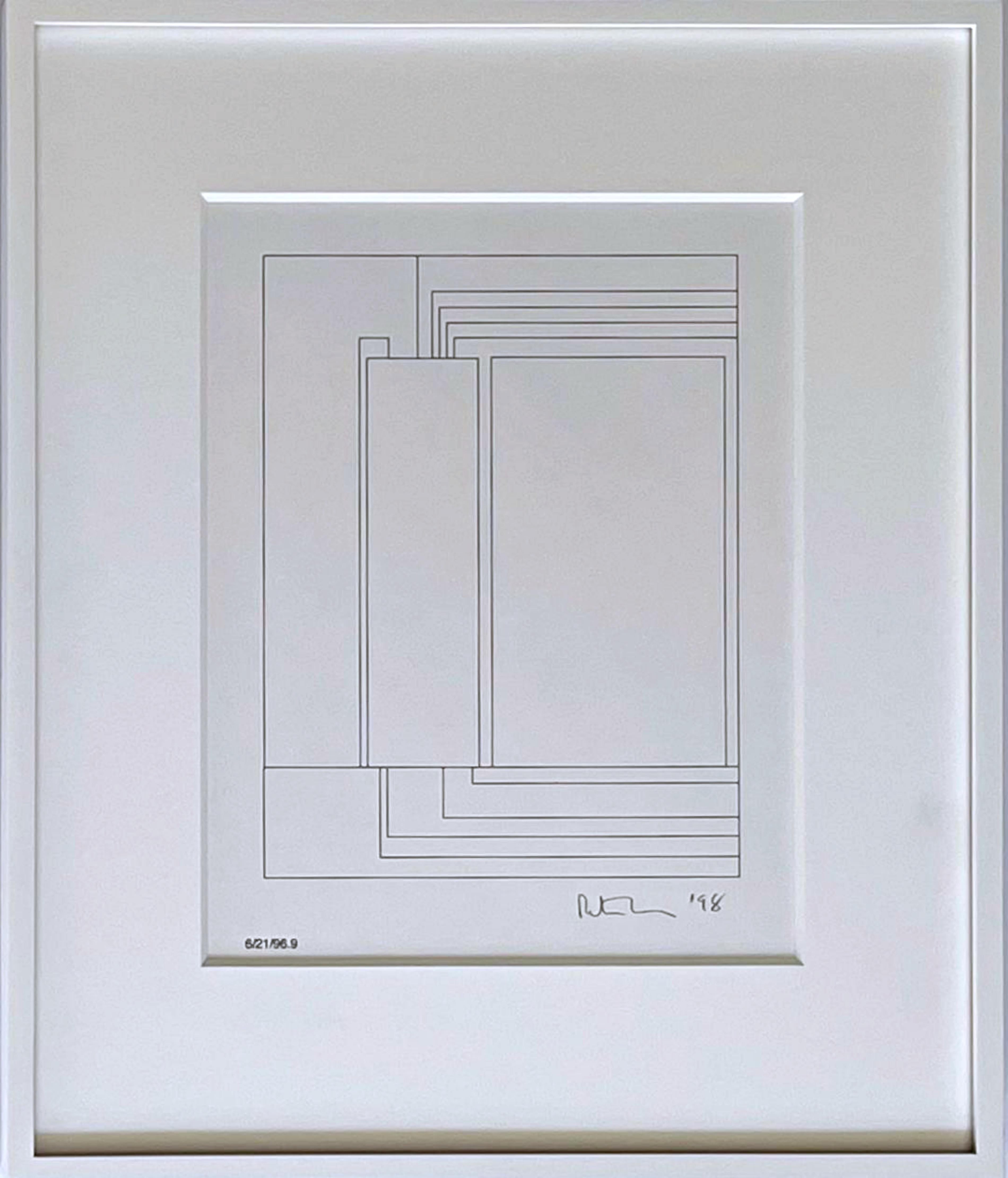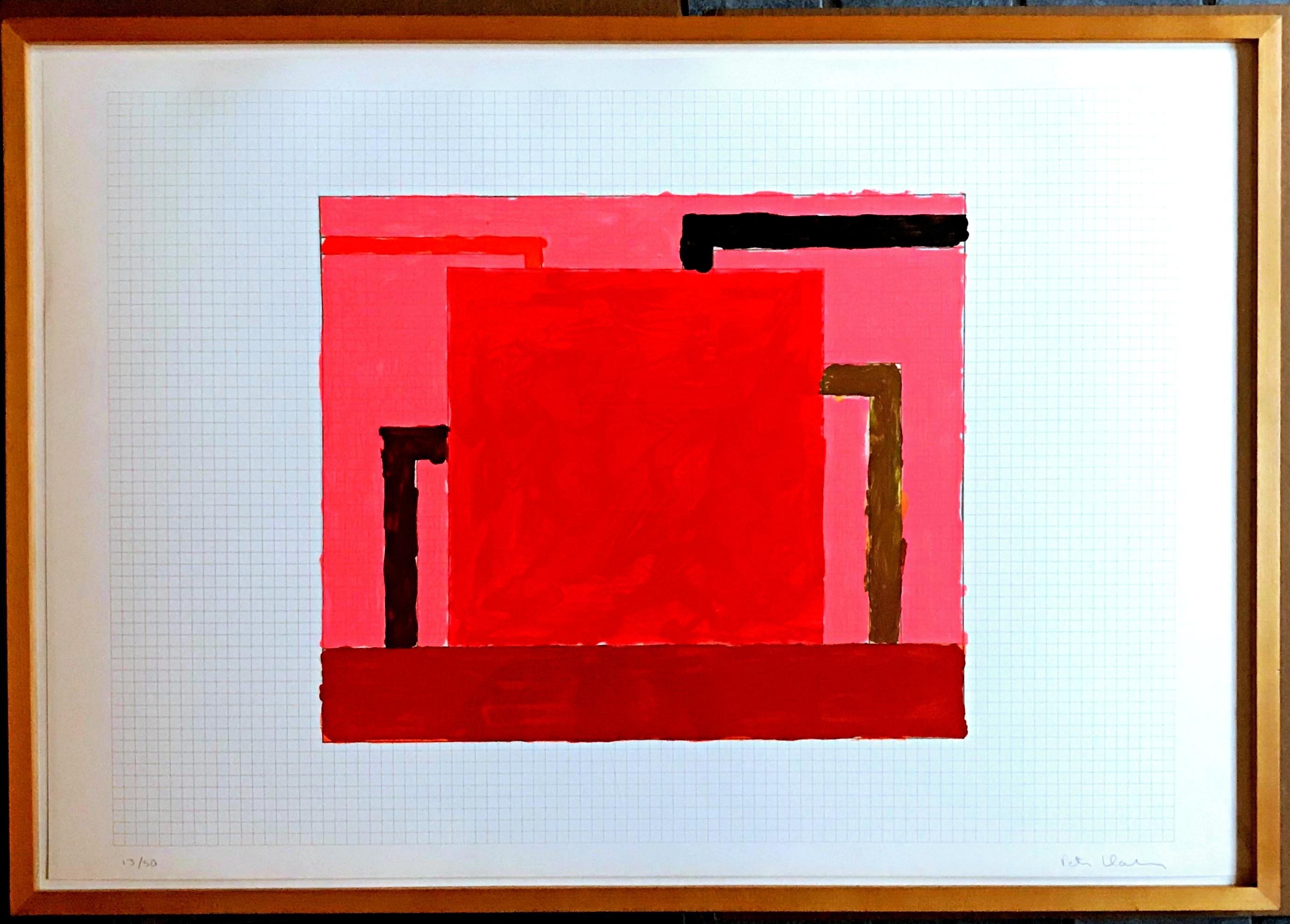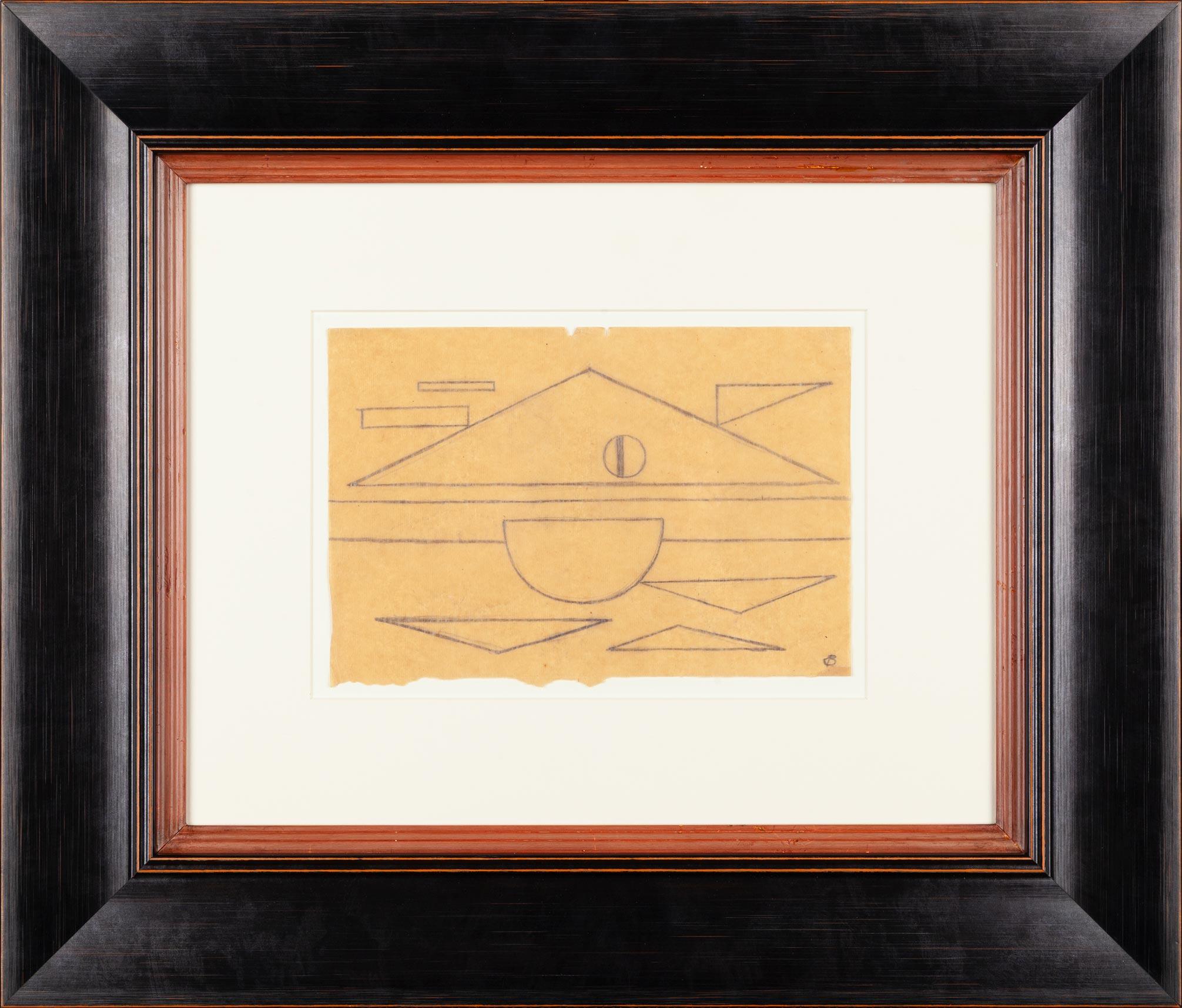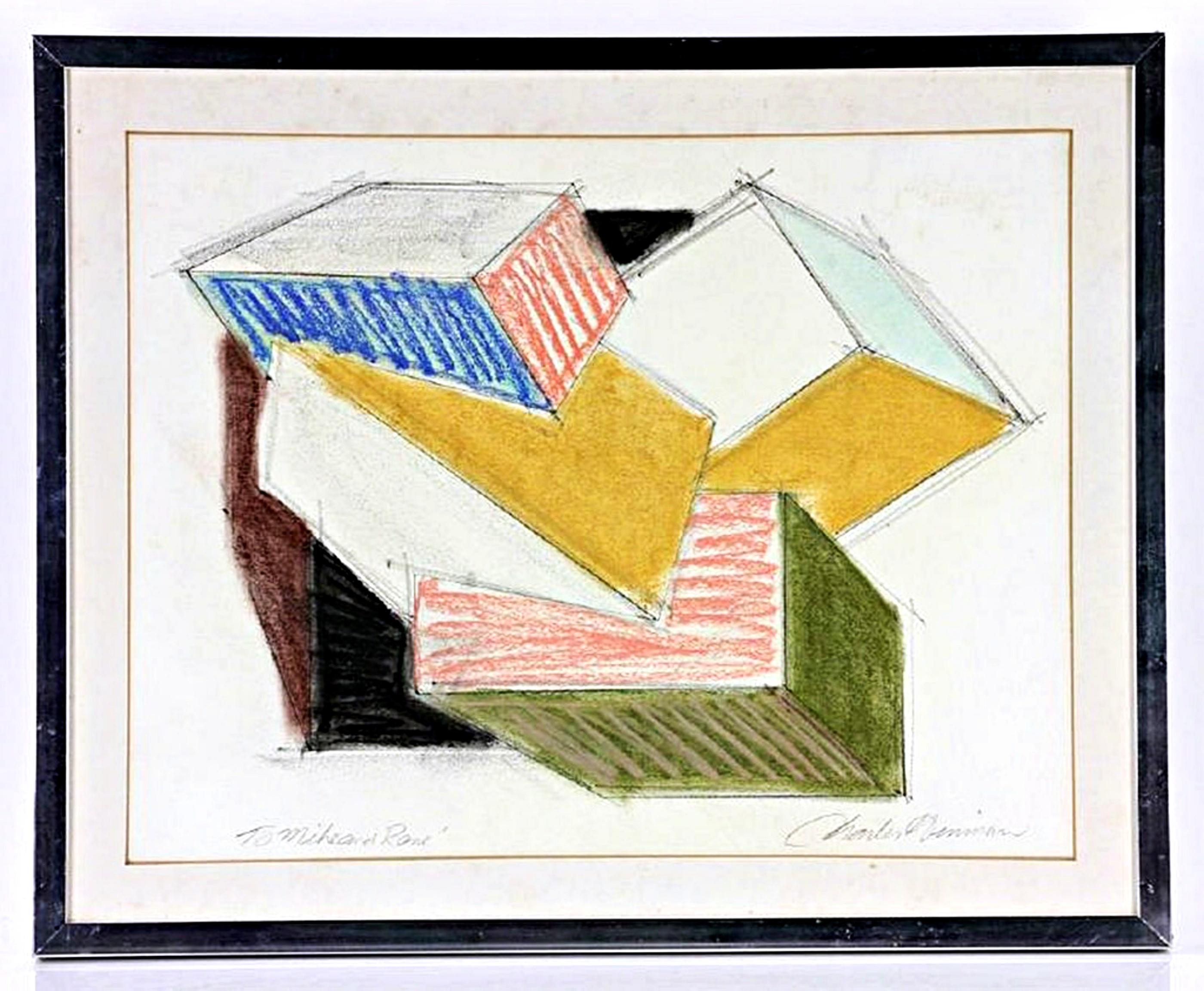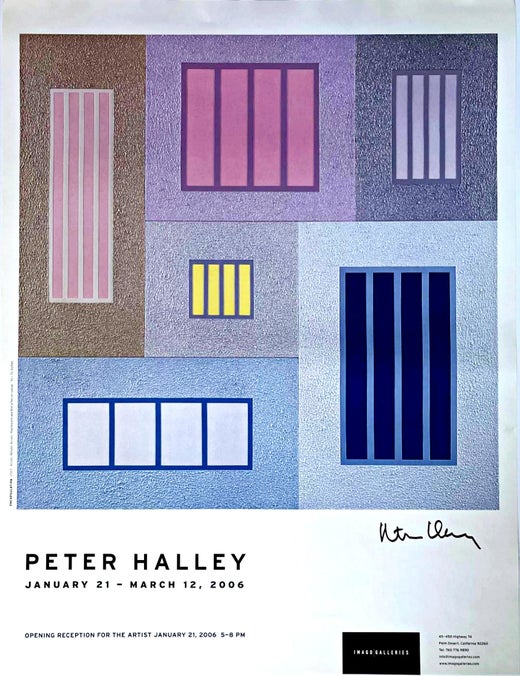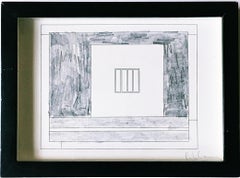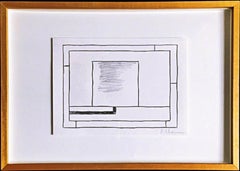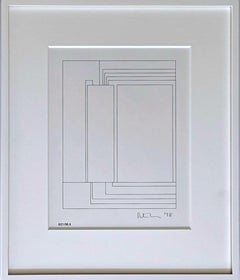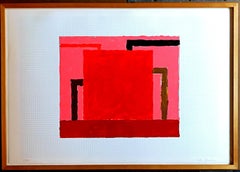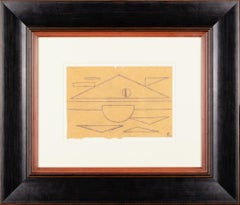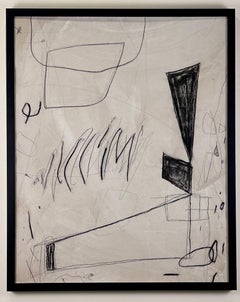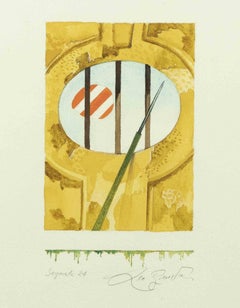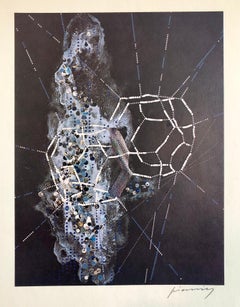Items Similar to Prison 30, unique signed drawing 1990s geometric abstraction by Peter Halley
Want more images or videos?
Request additional images or videos from the seller
1 of 6
Peter HalleyPrison 30, unique signed drawing 1990s geometric abstraction by Peter Halley1995
1995
$2,500
£1,912.70
€2,187.47
CA$3,559.78
A$3,855.67
CHF 2,042.13
MX$46,647.85
NOK 25,672.79
SEK 23,932.50
DKK 16,337
About the Item
Peter Halley
Prison 30, 1995
Original graphite drawing on paper
Pencil signed on the recto. Titled and dated verso.
This unique work on paper was created by Peter Halley in 1995 to benefit the AIDS Community Research Initiative of America (ACRIA) in New York. It is featured in the hardback book, "Unframed: Artists Respond to AIDS, AIDS Community Research Initiative of America," pg. 21.
Measurements:
Artwork: 5 inches x 7 inches
This work is unframed.
"My paintings have a very simple vocabulary: I call the rectangles either prisons or cells, and they’re connected by lines that I call conduits. For whatever reason, ever since I was a very young person, I made geometric paintings, and I grew up in the era of Minimalism. And the Minimalist artists generally said “these forms don’t refer to anything; they’re geometric forms, they have no relationship to the outside world.” And to me, that didn’t make sense. I thought, “our whole technological world is full of geometric forms.” And for the Minimalist artists, geometry represented a kind of ideal form: Platonic squares and circles. But for me, I began to think, “well, geometry is also kind of a prison. If you’re in your office or in front of your computer, it’s also kind of keeping you in a box.” So my vocabulary came about in reaction to Minimalism, trying to bring back a relationship between Geometric Abstraction and the world we live in….” - Peter Halley
Peter Halley Biography
Peter Halley was born in 1953 in New York. He began his formal training at Phillips Academy in Andover, Massachusetts, from which he graduated in 1971. During that time, Halley read Josef Albers’s Interaction of Color (1981), which would influence him throughout his career. From 1973 to 1974 Halley lived in New Orleans, where he absorbed the vibrant cultural influences of the city, began using commercial materials in his art, and first became acquainted with the writings of earthwork artist Robert Smithson. In 1975 the artist graduated from Yale University, New Haven, with a degree in art history. After Yale, Halley returned to New Orleans, where he received an MFA in painting from the University of New Orleans in 1978. He had his first solo exhibition at the Contemporary Art Center, New Orleans, that same year.
In 1978 Halley spent a semester teaching art at the University of Louisiana, Lafayette. He has continued to teach throughout his career. In 1980, Halley moved back to New York and had his first solo exhibition in the city at PS122 Gallery. At this time, Halley was drawn to the pop themes and social issues addressed in New Wave music. Inspired by New York’s intense urban environment, Halley set out to use the language of geometric abstraction to describe the actual geometricized space around him. He also began his iconic use of fluorescent Day-Glo paint.
In 1984, Halley started to exhibit with the International With Monument gallery, becoming closely associated with the organization and its artists, who exhibited conceptually rigorous work in a market-savvy, coolly presented space that stood in stark contrast to the bohemian, Neo-Expressionist flair of the East Village art scene at the time. In 1986, an exhibition of four artists from International With Monument at the Sonnabend Gallery in New York heralded the group’s growing success. By the late 1980s, Halley was exhibiting with prominent galleries in the United States and Europe. In 1989, an exhibition of his paintings traveled to the Museum Haus Esters, Krefeld, Germany; Maison de la culture et de la communication de Saint-Étienne, France; and Institute of Contemporary Arts, London. From 1991 to 1992, a retrospective toured Europe, with presentations at the CAPC Musée d’art contemporain de Bordeaux, France; Musée d’art contemporain, Lausanne, Switzerland; Museo nacional centro de arte Reina Sofía, Madrid; and Stedelijk Museum, Amsterdam. In 1992, the Des Moines Art Center hosted his first solo exhibition at a U.S. museum.
While developing his visual language, Halley became interested in French post-structuralist writers, including Jean Baudrillard, Guy Debord, Michel Foucault, and Paul Virillio, all of whom shared his concern with the character of social spaces in a post-industrial society. In 1981, he published his first essay “Beat, Minimalism, New Wave, and Robert Smithson” in Arts, a New York–based magazine that would publish eight of his essays before the decade’s end. Halley’s writings became the basis for Neo-Geometric Conceptualism (also known as Neo-Geo), the offshoot of Neo-Conceptualism associated with the work of Ashley Bickerton, Halley, and Jeff Koons. In 1988, the artist’s writings were anthologized in Collected Essays, 1981–1987, and again in 1997 in a second anthology, Recent Essays, 1990–1996.
In the mid-1990s, Halley began to produce site-specific installations for museums, galleries, and public spaces. These characteristically brought together a range of imagery and mediums, including paintings, wall-size flowcharts, and digitally generated wallpaper prints. Halley has executed permanent installations at the Dallas/Fort Worth International Airport, Texas, and the Gallatin School of Individualized Study at New York University. In 2011, his installation of digital prints Judgment Day was installed in the Palazzo Bembo in Venice as a part of the exhibition Personal Structures during the Venice Biennale. Halley has taught at the School of Visual Arts, New York; the University of California, Los Angeles; and Columbia University. He subsequently served as the Director of Graduate Studies in Painting and Printmaking at the Yale University School of Art from 2002 to 2011. From 1996 to 2006 he also published index magazine. Halley lives and works in New York.
-Courtesy Guggenheim
- Creator:Peter Halley (1953, American)
- Creation Year:1995
- Dimensions:Height: 5 in (12.7 cm)Width: 7 in (17.78 cm)
- Medium:
- Movement & Style:
- Period:
- Condition:minor, unobtrusive pinholes to the corners.
- Gallery Location:New York, NY
- Reference Number:1stDibs: LU1745215375202
Peter Halley
Peter Halley is an American artist known for his distinctive geometric paintings that explore the intersection of technology, society, and architecture. Born in 1953 in New York City, Halley developed an early interest in art and went on to study at Yale University, where he received his Master of Fine Arts degree in 1978.Halley's work is characterized by vibrant, flat colors and repetitive, abstract forms, often resembling circuit boards or prison cells. His paintings reflect his fascination with the effects of technology on human interaction and the isolation of modern society. Halley coined the term "prison cells" to describe the confined spaces and social structures that he believes have been created by technology and urban architecture. Throughout his career, Halley has exhibited his work internationally, gaining recognition for his unique style and thought-provoking concepts. He has also been involved in art criticism and writing, contributing to various publications and expanding the discourse on contemporary art. Today, Peter Halley's art continues to captivate audiences, provoking discussions about the impact of technology on our lives and the nature of human connections in an increasingly digital world. His contributions have made him an influential figure in the field of contemporary art.
About the Seller
5.0
Gold Seller
Premium sellers maintaining a 4.3+ rating and 24-hour response times
Established in 2007
1stDibs seller since 2022
466 sales on 1stDibs
Typical response time: 2 hours
- ShippingRetrieving quote...Shipping from: New York, NY
- Return Policy
More From This Seller
View AllPrison 14, Unique, signed, Graphite pencil and ink drawing on paper, Framed
By Peter Halley
Located in New York, NY
Peter Halley
Prison 14, 1995
Graphite pencil and ink drawing on paper. Hand signed. Titled. Dated. Framed.
Hand signed on lower right front corner
Unique
Frame included
Unique earli...
Category
1990s Abstract Geometric Abstract Drawings and Watercolors
Materials
Ink, Graphite
Geometric Abstraction (unique, signed graphite drawing gifted to fellow artist)
By Peter Halley
Located in New York, NY
Peter Halley
Untitled Geometric Abstraction, ca. 1990
Graphite and Ink
Signed in graphite pencil by Peter Halley; lower right front
Frame included: floated and framed in wood frame
U...
Category
1990s Abstract Geometric Abstract Drawings and Watercolors
Materials
Ink, Graphite
Peter Halley, Hand signed & dated original ink & graphite drawing; unique Framed
By Peter Halley
Located in New York, NY
PETER HALLEY
6/21/96.9, 1998
Graphite and ink drawing
Hand-signed by artist, signed and dated in graphite lower right front; lower left front bears title: 6/21/96.9
Frame included: elegantly matted and framed in a hand made museum frame with UV plexiglass
signed and dated in graphite lower right front; lower left front bears title: 6/21/96.9
This is a unique work
Frame included: elegantly floated and framed in a museum quality hand made white wood frame under UV plexiglass
Measurements:
Framed
16.5 inches vertical by 13 inches horizontal by 1.5 inches
Artwork (visible)
10 inches vertical by 8 inches horizontal
Peter Halley Biography
Peter Halley was born in 1953 in New York. He began his formal training at Phillips Academy in Andover, Massachusetts, from which he graduated in 1971. During that time, Halley read Josef Albers’s Interaction of Color (1981), which would influence him throughout his career. From 1973 to 1974 Halley lived in New Orleans, where he absorbed the vibrant cultural influences of the city, began using commercial materials in his art, and first became acquainted with the writings of earthwork artist Robert Smithson. In 1975 the artist graduated from Yale University, New Haven, with a degree in art history. After Yale, Halley returned to New Orleans, where he received an MFA in painting from the University of New Orleans in 1978. He had his first solo exhibition at the Contemporary Art Center, New Orleans, that same year.
In 1978 Halley spent a semester teaching art at the University of Louisiana, Lafayette. He has continued to teach throughout his career. In 1980, Halley moved back to New York and had his first solo exhibition in the city at PS122 Gallery. At this time, Halley was drawn to the pop themes and social issues addressed in New Wave music. Inspired by New York’s intense urban environment, Halley set out to use the language of geometric abstraction to describe the actual geometricized space around him. He also began his iconic use of fluorescent Day-Glo paint.
In 1984, Halley started to exhibit with the International With Monument gallery, becoming closely associated with the organization and its artists, who exhibited conceptually rigorous work in a market-savvy, coolly presented space that stood in stark contrast to the bohemian, Neo-Expressionist flair of the East Village art scene at the time. In 1986, an exhibition of four artists from International With Monument at the Sonnabend Gallery in New York heralded the group’s growing success. By the late 1980s, Halley was exhibiting with prominent galleries in the United States and Europe. In 1989, an exhibition of his paintings traveled to the Museum Haus Esters, Krefeld, Germany; Maison de la culture et de la communication de Saint-Étienne, France; and Institute of Contemporary Arts, London. From 1991 to 1992, a retrospective toured Europe, with presentations at the CAPC Musée d’art contemporain de Bordeaux, France; Musée d’art contemporain, Lausanne, Switzerland; Museo nacional centro de arte Reina Sofía, Madrid; and Stedelijk Museum, Amsterdam. In 1992, the Des Moines Art Center hosted his first solo exhibition at a U.S. museum.
While developing his visual language, Halley became interested in French post-structuralist writers, including Jean Baudrillard, Guy Debord, Michel Foucault, and Paul Virillio, all of whom shared his concern with the character of social spaces in a post-industrial society. In 1981, he published his first essay “Beat, Minimalism, New Wave, and Robert Smithson” in Arts, a New York–based magazine that would publish eight of his essays before the decade’s end. Halley’s writings became the basis for Neo-Geometric Conceptualism (also known as Neo-Geo), the offshoot of Neo-Conceptualism associated with the work of Ashley Bickerton, Halley, and Jeff Koons. In 1988, the artist’s writings were anthologized in Collected Essays, 1981–1987, and again in 1997 in a second anthology, Recent Essays, 1990–1996.
In the mid-1990s, Halley began to produce site-specific installations for museums, galleries, and public spaces. These characteristically brought together a range of imagery and mediums, including paintings, wall-size flowcharts, and digitally generated wallpaper prints. Halley has executed permanent installations at the Dallas/Fort Worth International Airport, Texas, and the Gallatin School of Individualized Study at New York University. In 2011, his installation of digital prints Judgment Day...
Category
1990s Abstract Geometric Abstract Drawings and Watercolors
Materials
Ink, Graphite
Peter Halley, CORE Geometric Abstraction Silkscreen & Lithograph Signed/N Framed
By Peter Halley
Located in New York, NY
Peter Halley
Core, 1991
Limited Edition Silkscreen with lithography on Coventry Rag paper.
Pencil signed and numbered 13/50 on the front
Publisher: Edition Schellmann & Pace Edit...
Category
1990s Abstract Geometric Abstract Prints
Materials
Lithograph, Screen
Unique signed pastel & graphite work Geometric Abstraction Minimalist painting
By Charles Hinman
Located in New York, NY
Charles Hinman
Untitled Geometric Abstraction (Hand Signed), 1980
Pastel & Graphite painting on Paper
Signed and dedicated to "Michael and Rene" in graphite by the artist on the fron...
Category
1980s Abstract Geometric Abstract Drawings and Watercolors
Materials
Pastel, Pencil, Graphite
Untitled Geometric Abstraction Minimalist painting unique signed renowned artist
By Winston Roeth
Located in New York, NY
An exquisite work of geometric abstraction by this celebrated artist
Winston Roeth
Untitled, ca. 1996
Pastel on handmade paper
Hand signed on the front
Frame included: Floated and fr...
Category
20th Century Abstract Geometric Abstract Drawings and Watercolors
Materials
Oil Pastel, Pastel, Handmade Paper
You May Also Like
Untitled (Prison Drawing)
By Rudolf Bauer
Located in Columbia, MO
Original drawing by Rudolf Bauer, signed 'B' lower recto.
Rudolf Bauer was born in 1889 into a comfortable, but not well-to-do, family on the border between Germany and Poland, and ...
Category
Early 20th Century Abstract Geometric Abstract Drawings and Watercolors
Materials
Paper, Pencil
Untitled #537 by Murray Duncan – Original Contemporary Mixed Media on Paper
Located in Toronto, Ontario
Untitled #537 by Murray Duncan – Contemporary Mixed Media on Paper
Size: 32" x 40"
Unframed, signed on the back
A striking exploration of form and movement, Untitled #527 by Murray ...
Category
21st Century and Contemporary Abstract Geometric Abstract Paintings
Materials
Oil Crayon, Acrylic, Pencil
Signal 24 - Drawing by Leo Guida - 1970s
By Leo Guida
Located in Roma, IT
Signal 24 is a contemporary artwork realized by Leo Guida in 1970s
Mixed colored watercolor on paper.
Hand signed, titled on the lower margin
Includes frame: 63.5 x 49 cm
Leo Gui...
Category
1970s Abstract Abstract Prints
Materials
Watercolor
Pencil Signed Abstract Geometric Graphic Design Lithograph Print, Bauhaus Artist
By M. Peter Piening
Located in Surfside, FL
M. Peter Piening was born on March 14, 1908 in Grabow, Germany. He began his education at a private school in Italy, studied at the Jesuit school of Kloster Ettal in Bavaria, and attended the German Stettin Gymnasium, where he graduated in 1926. Between 1926 and 1928 Piening studied design at the Bauhaus in Dessau, Germany. There he was taught by multiple famous twentieth-century artists, including Joseph Albers, Paul Klee and Mies van der Rohe. After receiving his master’s degree from the Bauhaus in 1929, Piening enrolled at the University of Berlin and obtained his PhD in philosophy in 1931.
Piening spent his early career free-lancing as an illustrator and artist for various publishing companies, eventually settling in Paris to work for Condé-Nast’s French publication of Vogue. In 1934 he moved to the United States to work in Condé-Nast’s New York City office. For the next two decades, Piening worked for many important advertising agencies and magazine publishers, including the N. W. Ayer and J. Walker Thompson agencies and Life and Fortune magazines. As art director for Life in the 1930s and for Fortune in the 1940s, Piening completely redesigned the layout of each magazine. He also redesigned the layouts for thirty-four other major American magazines, including Town & Country and Cosmopolitan.
Through his design work, Piening had a great impact on the American public, although the millions who encountered his work most likely never knew his name. Between 1934 and 1964, Piening designed over sixty logos and trademarks for internationally-known products and companies. His most widely-recognized logo may have been the three interlocking rings of Ballantine beer. Piening’s other trademark designs include the Lincoln Zephyr...
Category
1960s Abstract Geometric Abstract Prints
Materials
Lithograph
Untitled #530 by Murray Duncan – Original Contemporary Mixed Media on Paper
Located in Toronto, Ontario
Untitled #530 by Murray Duncan – Contemporary Mixed Media on Paper
Size: 32" x 40"
Unframed, signed on the back
A striking exploration of form and movement, Untitled #527 by Murray ...
Category
21st Century and Contemporary Abstract Geometric Abstract Paintings
Materials
Oil Crayon, Acrylic, Pencil
"State 2" Abstract Geometric Lithograph
By Patricia A. Pearce
Located in Soquel, CA
Dramatic abstract geometric lithograph by Patricia A. Pearce (American, b. 1948). Labeled "State 2" in the lower left corner. This piece ...
Category
1980s Abstract Geometric Abstract Prints
Materials
Paper, Lithograph
